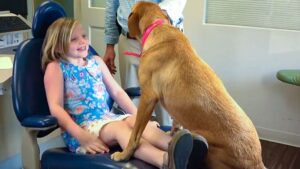Visiting the dentist is a scary experience for many children. The dentist is a virtual stranger, even after several visits. Plus, the dentist and hygienists wear masks that cover their faces for most of the visit, making them appear even less friendly. It can be a very over-stimulating experience with the bright lights, loud buzzing and chemical smells. And the expectation of holding still for an extended length of time is frustrating for many children.
Fortunately, there are some ways to make the visit a bit less frightening and easier to handle:
- Find a pediatric dentist. Pediatric dentists have specialized training in treating children. Their offices are often designed to be more comfortable and inviting to children. If your child has special needs, ask if they can handle your child’s special needs. Some dentists, like Dr. Angelica Rohner of Angelica Rohner Pediatric Dentistry have even worked to get sensory inclusive certification.
- Start early. The American Academy of Pediatric Dentistry recommends that children see a pediatric dentist as soon as their first tooth comes in, typically between six and twelve months of age. Getting children accustomed to dental visits from a young age often makes visits less traumatic. Dr. Baker Chambliss of Medplex Pediatric Dentistry says children should visit when the first tooth appears, and frequency depends on each child, but most should visit twice per year for cleanings and exams. “Starting young gets your child more comfortable with dental appointments and with the dentist you choose for his or her care,” Chambliss says.
“Get an early start!” says Rohner. “The first visit is important to the parent and child in order to get a jump start on excellent dental health…children learn that the dental office is a safe and fun place to go and helps eliminate dental fears at an early age,” Rohner explains.
- Tell your child what to expect. Children typically only see the dentist twice a year. They may forget what happens at the visits in between appointments. Walk them through what to expect before each visit. Read books about going to the dentist.
- Work with a dentist that tells your child what to expect. Dr. Olga M. Sanchez-Hernandez of McCalla Orthodontics and Pediatric Dentistry says they use a technique called “Tell-Show-Do” where they explain what they are going to do, show the child on their hand or theirs what they are going to do, then they do it in the mouth. “Repetition is key!” Sanchez-Hernandez adds. “You would be amazed to know that most children are naturally curious and welcome new experiences with a positive attitude.”
“Parents are always encouraged to speak positively about going to the dentist”, says Dr. Clark Thomas of Thomas Pediatric Dentistry. “Children tend to feed off their parents’ emotions and fears. Generally speaking, if the parents have a calm and relaxed approach about the dentist, typically the children will follow suit.”
- Don’t gloss over parts that they struggled with last time. For example, if they became agitated when it was time to swish the fluoride rinse around their mouth, gently let them know that they will have to do it again. Neglecting to mention it could lead to more anxiety, as well as possibly distrust in you when they are confronted with it again.
Medplex Pediatric Dentistry has a unique feature to help comfort children – their comfort dogs, Sister and Sugar. “They can sit alongside or with a patient and their calm, loving presence minimizes stress and anxiety,” Chambliss says. “We also provide games and TV for fun and relaxing appointments.”
- Practice good dental hygiene at home. Brushing and flossing your child’s teeth daily will help keep teeth and gums healthy. This may result in quicker and easier dental visits. Feeding your child a healthy diet and limiting sweets will also help accomplish this.
- Let the braver child go first. Most people with multiple children have the oldest child receive treatment first. This isn’t necessarily the best order. If a younger child is less fearful, let them go first.
- Start some traditions. A few days before the dentist appointment, start reading books or watching cartoons about dentists, teeth and tooth care. Find a song about going to the dentist or make up one of your own. Sing it in the car on the way to the appointment. Have a special plan for after the dentist, such as visit to the park or trip to the movie theater. Do these things before and after every visit to give your children good memories of going to the dentist.
- Deal with your own fears. Many adults still have severe dental anxiety. Children pick up on their parent’s worries. Your child won’t be able to be calm or relaxed if she knows you aren’t. Take time to address your own issues before the appointment so you don’t project your negative feelings onto your child’s experience.
In fact, Sanchez-Hernandez says to keep a positive attitude regardless of your past dental experiences. “Act natural and be relaxed,” she explains. And do not anticipate giving too much information unless you are sure it would be beneficial to your particular child.
- Parents of children with special needs, especially those with challenging behavior, can often feel overwhelmed by dental visits, says Dr. Stephen Mitchell of Sparks Dental Clinic at UAB. Places like the Sparks Clinic and pediatric dentists who also specialize with treating children with special needs are a good way to go, and ask if the dentist can handle your child’s special needs before you book the appointment.
Rachael Moshman is a mom, freelance writer and blogger. She actually enjoys going to the dentist. Find her at www.rachaelmoshman.com. Carol Muse Evans contributed to this story.





